Did you know that GPS satellites helped confirm Albert Einstein’s theory of general relativity? What’s more: without taking general relativity into account when programming the calculations for these satellites, GPS couldn’t work at all. It all comes down to the satellite’s distance from the center of the earth and, by extension, the proximity of the satellite to the center of a large source of gravity.
According to general relativity space and time are one and the same, which is appropriately call spacetime.
Gravity (which isn’t technically a force but a curving of spacetime) can warp space, causing objects (or photons of light) to travel in a curved trajectory – at least from our relative perspective. The closer you are to a massive source of gravity, the more spacetime is curved; and the farther away you are, the flatter spacetime becomes. Imagine a heavy bowling ball in the center of a trampoline (spacetime): if you place a smaller ball on the edge of the trampoline it will roll toward the heavy bowling ball. There is no force (gravity) pulling them together, although it appears that way if you can’t see the trampoline (spacetime). It’s the distortion of spacetime by heavy objects that makes it appear to us as though gravity exists.
That curvature directly affects your experience of time since a curved path is necessarily longer than a straight(er) path.
Understanding this idea is crucial for satellites to work. Since they are much farther from the center of earth’s gravity, they have a less curved trajectory through spacetime and therefore experience time slightly faster than we do on earth’s surface. The difference is extremely small, on the scale of a few millionths of a second, but that difference would add up quickly.
A measurement of time is how GPS functions: we measure the time it takes for a signal to travel from the satellite to you and back, giving a precise distance, and then comparing that to other satellite measurements (needing at least four to triangulate the exact position). Since the speed of light is 186,000 miles per second, these measurements have to be very precise to accurately calculate position. The more precise the clock, the more precise the position.
This requires a perfectly synced clock, but as time moves faster for satellites a clock on the ground will slowly drift out of sync. Within days, the satellite would think that you are miles from where you actually are because the relative experience of time between you and the satellites has drifted, throwing the system off.
For GPS to continue functioning, the clock on the satellite is continuously adjusted to stay in sync with our ground-based clocks. This is exactly what Einstein’s calculations for the general theory of relativity predict, meaning that every single time we use a satellite GPS we are independently verifying the fundamental truth of this theory.
For that reason, satellites may be one of the most valuable scientific instruments orbiting the earth while providing a practical service for possibly billions every day.
So when Urwerk released the UR-220, an evolution of the very popular UR-210 that features the now-iconic Urwerk satellite display for the hours and minutes, it was one more tangential celebration of Einstein’s theory.
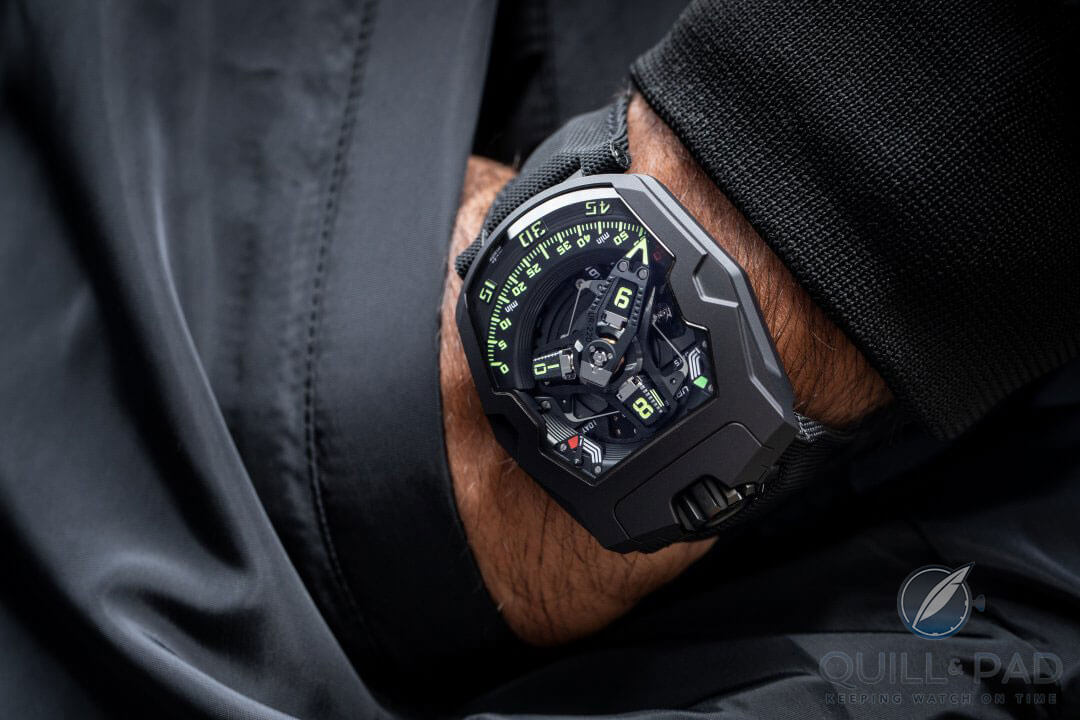
Urwerk UR-220 All Black on the wrist
The Urwerk UR-220 is also an incredibly awesome watch, so now let’s dig into it and see why it is on the list of my favorite watches.
Urwerk UR-220: the Falcon Project and All Black variations
“The Falcon Project” is the nickname for the evolution of the UR-210 into the 220, which sees the return of some legacy details from other models and the addition of some small changes to the function and aesthetic of the watch overall.
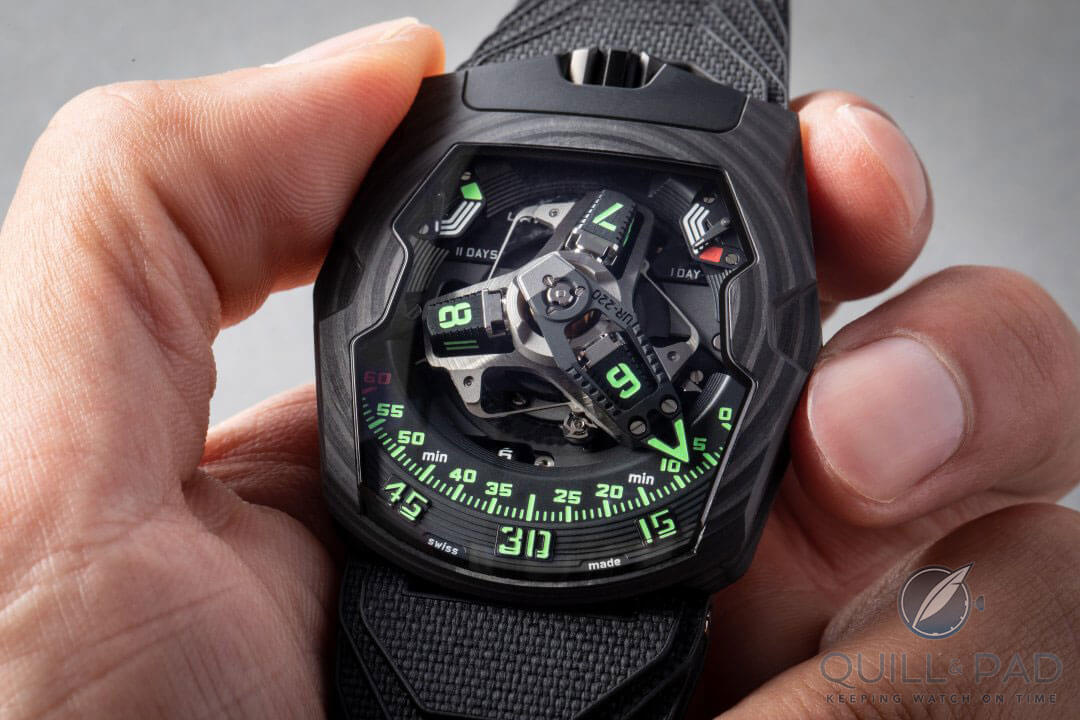
Urwerk UR-220 Falcon Project
The design may look wild but the concept is pretty straightforward, built around a retrograde minute hand and Urwerk’s ubiquitous orbiting satellite hours. The hours dock with the minute pointer as they pass along the minute track at the bottom of the dial, displaying the time quite clearly.
Above the time display on either side are power reserve indications, each representing 24 hours of the total 48-hour reserve. This represents a shift from the UR-210, which featured a winding efficiency indicator (an indication of how energetic you are while wearing it), which I’ll guess was slightly confusing, causing Urwerk to return to a feature more understandable to those not steeped in horological minutia.
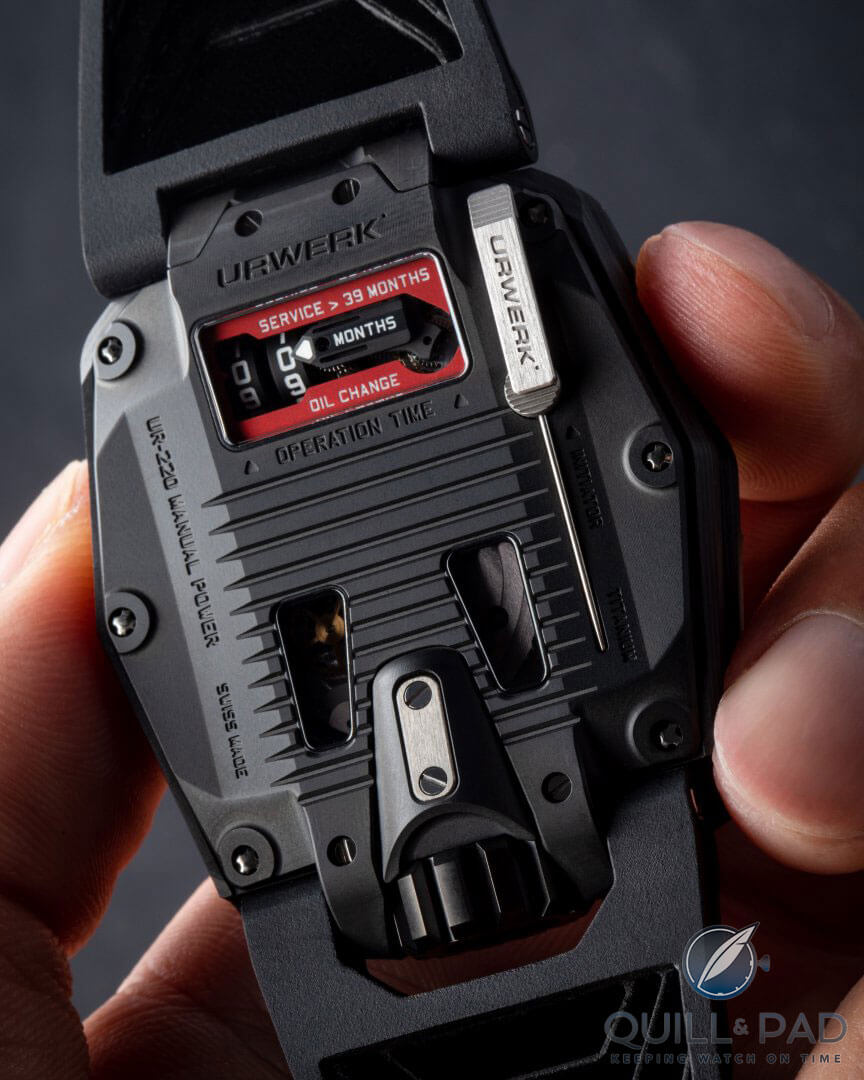
Back of the Urwerk UR-220 Falcon Project
And, yet, Urwerk chose to revive another bit of horological minutia, one that helps the owner keep the watch in its best form. On the rear of the case is an oil change indication, something found originally on the UR-110 that displays how long the watch has been ticking since its last “oil change.” It comes with a note that at 39 months one should send it in for service to prevent wear and damage of the movement.
The biggest change to personal use on the UR-220 is the removal of automatic winding. This was a feature on all the UR-210 pieces and now Caliber UR-7.20 is manually wound. This increases the wearer’s connection to the watch, but also makes it less versatile for some.
But if you are buying an Urwerk, it is likely to be less about practicality and more about what the watch actually is, which is that the UR-220 is an awesome update to the already awesome (and now retired) UR-210.
Urwerk UR-220: mechanics are the core
The awesomeness starts on the front with the very cool retrograde minutes combined with the satellite hours. The center of the dial is taken up by the satellite system, a triple-arm carriage that supports three hour blocks in the shape of truncated square cones.
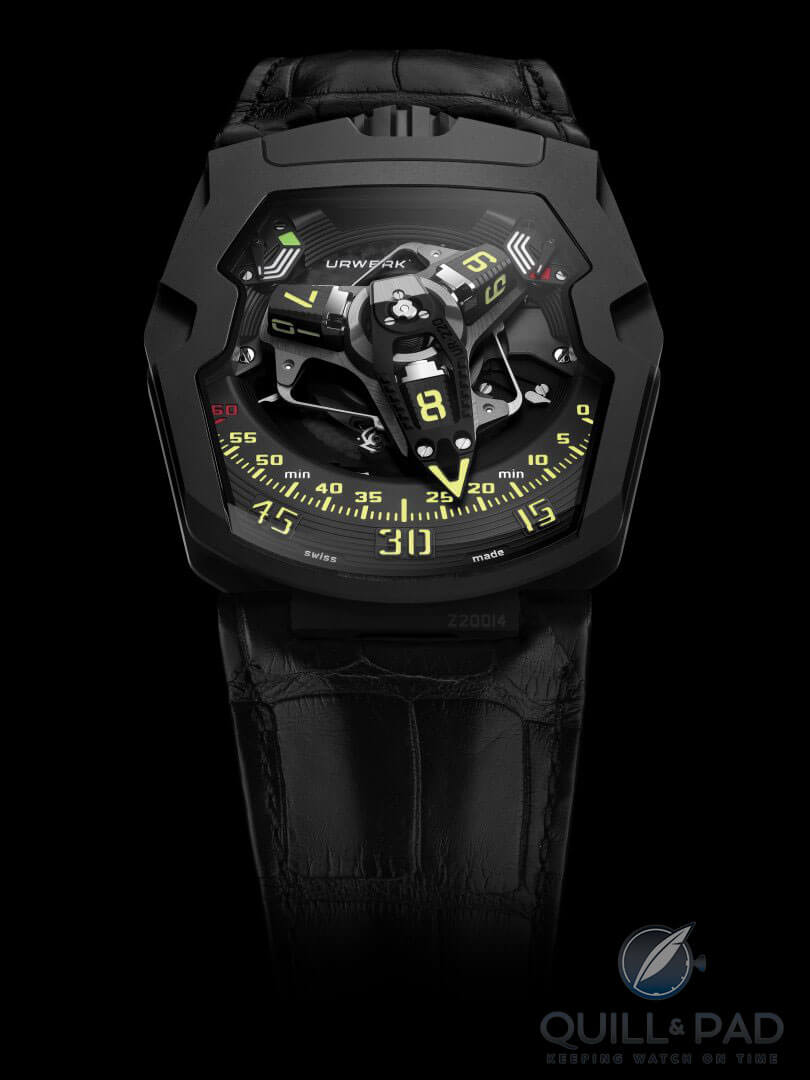
Urwerk UR-220 All Black
These hour blocks roll 90 degrees horizontally to the dial once every rotation of the carriage (every three hours) to work through the hours consecutively. This works via a pin set into the dial that engages with slots cut into the base of the hour blocks, turning them as the carriage passes. But an even more impressive feature is the retrograde minute hand that rides along with the carriage through one-third of its rotation.
Sandwiching the hour carriage, the minute pointer assembly rotates 120 degrees to display the minutes where it snaps back to join the next arm of the carriage at the top of the hour. This is accomplished thanks to a helical hairspring, very much like what you would find in a marine chronometer, which is slowly charged over the preceding hour.
At the top of the hour, the minute pointer is released from a spring and flies back to zero where a three-pointed ratchet wheel attached to the minute point re-engages with the next hour arm’s spring, beginning the journey again.
This function is pretty much instantaneous to the eye, but under slow motion bounces very energetically, showcasing the extreme forces the minute pointer assembly undergoes every hour, hence the necessity of regular service intervals.
This also shows why that oil change indicator is a smart thing to include, because it literally is keeping a record of approximately how many times that retrograde mechanism has tripped, just like knowing how many rounds have been fired from a rifle. The mechanical forces can add up to create component fatigue, so being able to check everything will ensure that the watch lasts not just for years but generations.
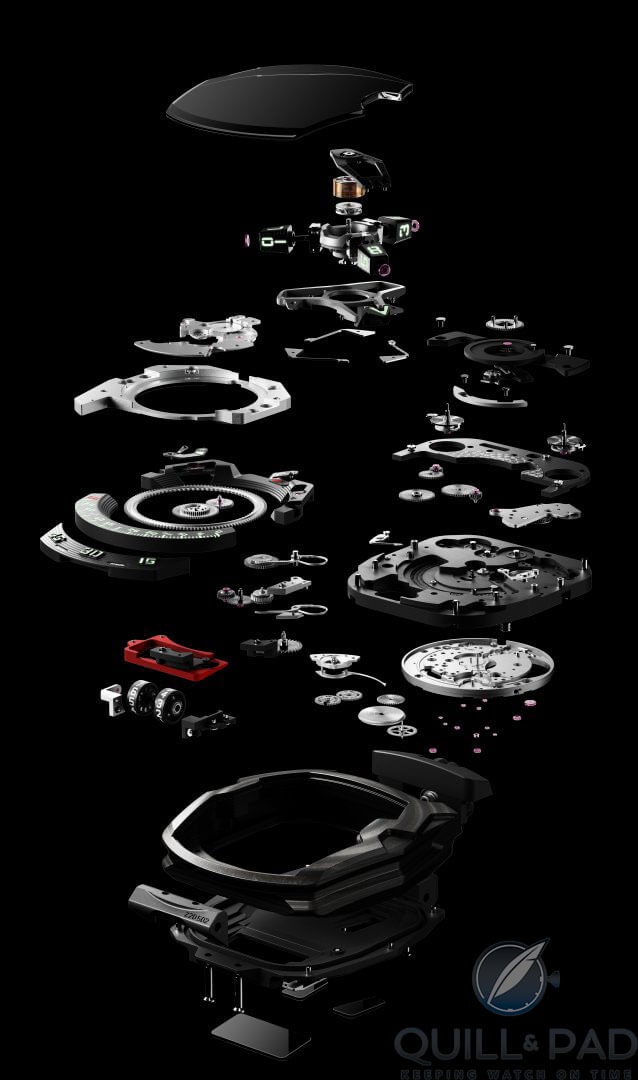
Exploded movement of the Urwerk UR-220 Falcon Project
Urwerk UR-220: closer connection thanks to oil change indicator
The oil change indicator is very cool too since it is functionally a calendar displaying large time scales. And unlike the preceding variation on the UR-110, it is not merely a dial this time but instead a digital display using twin cylinders rotating perpendicularly to the rotation plane of the movement. The mechanism is simple in design, but still requires careful design and fabrication to change direction of rotation for any movement, so there is even more mechanical creativity to fawn over.
Putting it on the rear of the case also keeps the front side relatively the same as the very popular UR-210, while still providing a very cool reason to take it off and show everyone (what . . . we all would do it if we owned one).
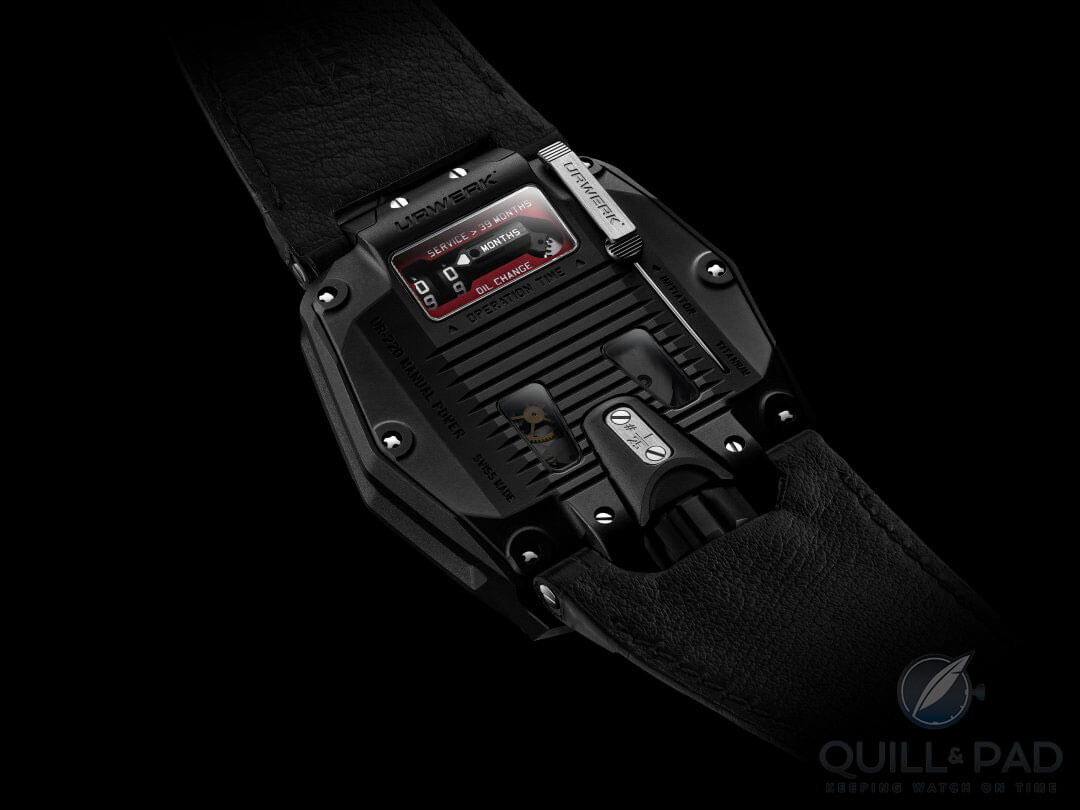
Oil change (service) indicator on the back of the Urwerk UR-220 All Black
Even more interestingly, the oil change indicator is started by the owner. On the rear of the case is a long pin inserted into a slot that holds the indicator at zero. When the owner gets the watch back after servicing, they must remove it to start the indicator counting.
When the owner sends the watch back for servicing, they include that pin as well. And once the reading has been zeroed, Urwerk reinstalls the pin for them to remove once again. This is a quirky yet very tactile connection to the watch that I can only imagine would have as much – or more – satisfaction than pulling that screen protector off a brand-new smartphone.
You know what I’m talking about. And if you don’t I’m sorry you don’t know one of modern technological life’s simplest pleasures.
Urwerk UR-220: architecture
Since the movement is new it has been optimized and slimmed down, resulting is a case three millimeters slimmer, a massive reduction. This makes the new thickness only 14.8 mm, which is still thick, but becomes much more reasonable for anyone on the fence about the size.
Taking advantage of this new case size, Urwerk decided it was the perfect time to create a case out of CPT, Carbon Thin Ply. The layered carbon case of the Falcon Project variation has very fine layers, only 150 microns thick, and with the sloping nature of the case shape the pattern is very striking. This version also has a titanium case back, which, when combined with the size reduction and carbon, makes this a very wearable watch.
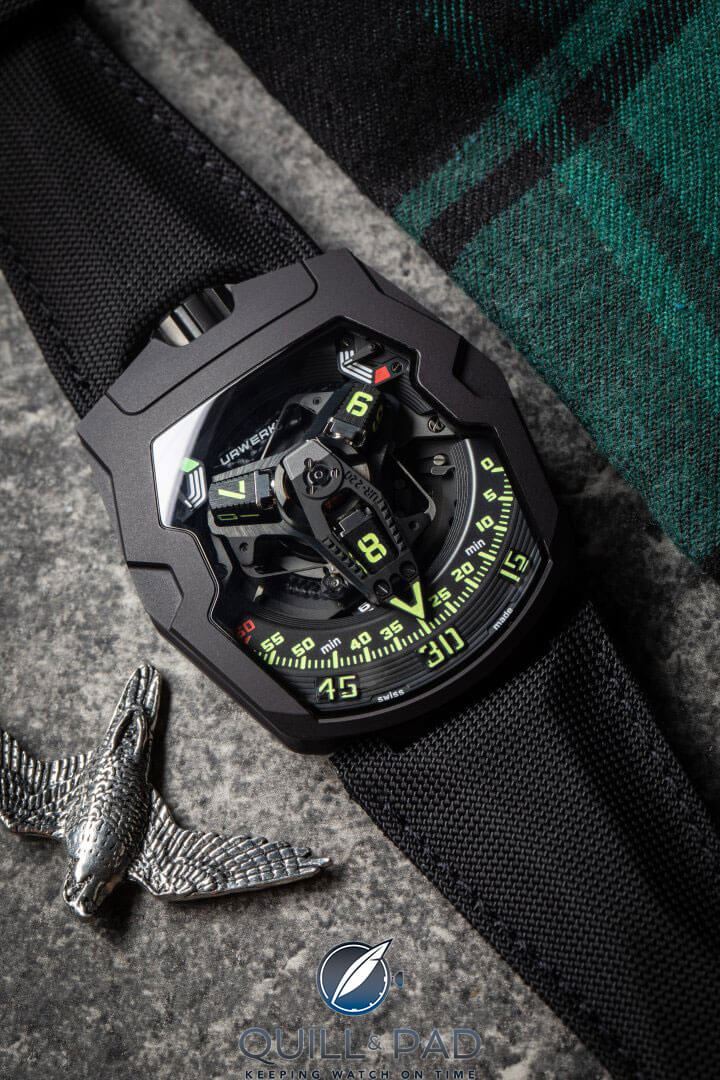
Urwerk UR-220 All Black
The All Black version returns to the more typical black DLC steel for the main case, though it still uses the titanium case back to reduce weight a bit. The weight increase through the steel might be welcome for some who still like a bit of heft on the wrist, providing options. The improvements are great additions to an already great design, which is why the architecture is largely visually unchanged across this watch.

Urwerk UR-220 Falcon Project on the wrist
Urwerk also stretched to create its first rubber strap on the Falcon Project UR-220, using the “Vulcarboné” process (basically vulcanized rubber). This provides a silky satin finish that makes it very nice to touch and less like a simple diving strap.
But, more importantly, it is molded to look similar to the brand’s typical textile straps featuring a multilayered visual design with recesses in the back to keep your skin from getting sweaty.
Just like Urwerk to do something people have done before but better, more uniquely, and in line with its already awesome design philosophy.
The UR-210 was a winner from day one for Urwerk, and the evolution into the UR-220 is fantastic, showcasing clear goals and a desire to double down on some great design and mechanical ideas.
As I mentioned in my opening, satellites are incredible machines for our scientific understanding, and the Urwerk satellites are incredible machines for our horological enjoyment. I hope it stays that way.
While I keep my fingers crossed that I’ll be able to hang out with Urwerk sometime soon, let’s break this watch down!
- Wowza Factor * 9.91 For me Urwerk will always be on the top of my charts; it’s just part of who I am!
- Late Night Lust Appeal * 100.01» 980.763m/s2 After nearly a decade of this amazing design, it still keeps me up at night pining for a chance to own one!
- M.G.R. * 69.9 As I’ve pointed out in the past I like mechanics more than watches, so a watch like Urwerk is always going to score very, very high for geekiness!
- Added-Functionitis * Moderate Dual power reserves are good, but a mechanical oil change indicator is going above and beyond. The watch may be moderately simple with what it tells you, but the way it does it is hardcore. Still, I would recommend regular-strength Gotta-HAVE-That cream to manage the sci-fi horological swelling of the Falcon Project!
- Ouch Outline * 11.4 Slipping while changing a miter saw blade! Remember, folks, wear gloves when changing saw blades lest you slip and nearly rip off the tip of your finger. Okay, that didn’t happen, but I did get a nasty cut that I kept hitting over and over for two weeks. But I’d gladly do it again if I was able to get my hands on a UR-220!
- Mermaid Moment * 8 Years Ago! I didn’t need to fall in love with something I fell in love with years ago – so this is just a continuing happy relationship!
- Awesome Total * 826.72 First take the length of the case in millimeters (52.9) and multiply by the thickness of the case (14.8), then add the width of the case (43.8) for a sweetly updated awesome total!
For more information, please visit www.urwerk.com/collections/ur-satellite/ur-220.
Quick Facts Urwerk UR-220 C81 The Falcon Project
Case: 43.8 x 52.9 x 14.8 mm, CPT carbon and black DLC-coated titanium
Movement: manual-winding Caliber UR-7.20, 48-hour power reserve, 28,800 vph/4 Hz frequency, base plate in ARCAP
Functions: satellite hours, retrograde minutes; dual power reserve, oil change indicator
Price: $162,000 / CHF 145,000
Quick Facts Urwerk UR-220 All Black
Case: 43.8 x 52.9 x 14.8 mm, black DLC-coated steel and black DLC-coated titanium
Movement: manual-winding Caliber UR-7.20, 48-hour power reserve, 28,800 vph/4 Hz frequency, base plate in ARCAP
Functions: satellite hours, retrograde minutes; dual power reserve, oil change indicator
Limitation: 25 pieces
Price: 130,000 Swiss francs
You may also enjoy:
Urwerk And The Gustave Sandoz Clock That Doesn’t Tell The Time
The Urwerk UR-110 Eastwood: A Tailor-Made Farewell Of Timber And Tweed
Leave a Reply
Want to join the discussion?Feel free to contribute!





















































These watches are a cool take on watch making and deserve a premium.but come on, this is just silly.